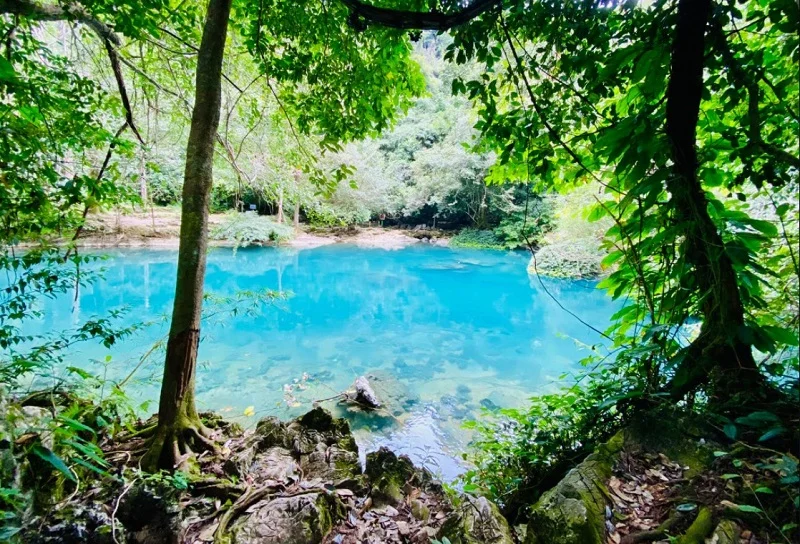
Deep in the rugged northern mountains of Vietnam, Pac Bo in Cao Bang Province is more than just a picturesque corner of the country — it is a sacred landmark in the nation’s revolutionary history. Surrounded by dense forests, limestone peaks, and crystal streams, Pac Bo was the place where President Ho Chi Minh secretly lived and worked after returning from overseas in 1941.
Here, under the protection of nature, he planned strategies, trained revolutionary cadres, and prepared for Vietnam’s eventual declaration of independence. Today, Pac Bo welcomes visitors who wish to experience both the raw beauty of the mountains and the enduring spirit of the nation’s struggle.
📍 Location & Meaning
Pac Bo lies in Truong Ha Commune, Ha Quang District, Cao Bang Province, close to the Chinese border. The name Pac Bo means “headwaters” in the Tay–Nung language, a fitting name since it sits near the source of the Khuoi Giang Stream.
When Ho Chi Minh returned to Vietnam in early 1941, he deliberately chose Pac Bo for its remoteness, natural cover, and closeness to the border — a strategic location for organizing the resistance. Even today, the area remains remarkably untouched, with the same lush bamboo groves, waterfalls, and mountain silhouettes that once shielded a revolution.
🏞 Highlights You Shouldn’t Miss
💧 Lenin Stream – A Ribbon of Turquoise
Formerly known as Khuoi Giang, this stream was renamed Lenin by Ho Chi Minh himself in honor of the Russian revolutionary leader. The water here is strikingly clear and tinted turquoise, reflecting the surrounding greenery. In the early morning, mist drifts over the surface, making it look like something from a watercolor painting. You can even spot small fish darting among smooth pebbles — the same serene view that Ho Chi Minh saw more than 80 years ago.
⛰ Karl Marx Mountain – The Silent Guardian
Standing tall above Lenin Stream is Karl Marx Mountain, also named by Ho Chi Minh to honor the German philosopher whose ideas inspired Vietnam’s independence movement. The slopes are thick with ancient trees and crisscrossed by narrow paths that were once used as secret trails. From the summit, you can take in a panoramic view of the valley — a blend of beauty and strategic advantage.
🪨 Coc Bo Cave – The Modest Command Center
Coc Bo Cave is perhaps the most historically charged spot in Pac Bo. This small limestone cave, only a few meters deep, was Ho Chi Minh’s home and office during his early days back in Vietnam. Inside, you’ll find his simple stone bed, a flat rock used as a desk, and a place where he often fished in the nearby stream.
It’s here that he wrote documents, taught political theory, and mapped out campaigns — all in near-total secrecy. The simplicity of the site is striking; it shows how little he needed to lead a movement that would change the course of the nation.
🏯 Ho Chi Minh Temple – A Place of Honor
Built in 2021 on Tieng Chay Hill, this stilt-house-style temple is a modern addition to the Pac Bo landscape. Visitors climb a gentle set of steps to reach it, passing through fragrant groves. Inside, offerings and incense pay tribute to Ho Chi Minh, making it not only a tourist stop but a spiritual site for locals and visitors alike.
🛖 Khuoi Nam Hut – A Quiet Refuge
About 1 km from Coc Bo Cave lies Khuoi Nam Hut, a modest wooden stilt house beside a stream. Ho Chi Minh lived here longer than at any other site in Cao Bang, using it as a retreat for writing and reflection. The sound of flowing water and chirping birds still fills the air, making it easy to imagine why he chose it as a base.
🚗 How to Get There
- From Cao Bang City: Around 50 km north via National Highway 3, then turn onto DT208 to reach Truong Ha Commune.
- From Ban Gioc Waterfall: Roughly 90–100 km (about 2–3 hours).
You can rent a motorbike for flexibility, take a private car, or hire a taxi. Public buses go part of the way, but you’ll still need a short motorbike ride to reach the site. The final stretch winds through hills, offering sweeping views of valleys and small villages.
🌤 Best Time to Visit
- October to May is the most pleasant period, with cool air, dry paths, and clear streams.
- June to September is lush and green, but summer rains can make the stream muddy and trails slippery.
Morning visits are ideal — the light is soft, the air is crisp, and the crowds are fewer.
🎟 Entrance & Visitor Info
- Adults: 20,000 VND
- Children over 10: 15,000 VND
- Children under 10: Free
Visitor Guidelines:
- Avoid touching historical artifacts.
- Keep noise levels low at sacred sites.
- Wear comfortable walking shoes for uneven ground.
- Bring drinking water, as shops are limited in the area.
🗝 Why Pac Bo Matters
From January 1941 to May 1945, Pac Bo served as the nerve center for Vietnam’s revolutionary movement. Within these quiet hills, strategies were formed that would lead to the August Revolution of 1945 and eventually the country’s independence.
Visiting Pac Bo is more than a scenic day trip — it’s a journey into a defining chapter of Vietnam’s story. Standing by Lenin Stream or inside Coc Bo Cave, you can almost hear the echoes of quiet determination that once filled these mountains.



